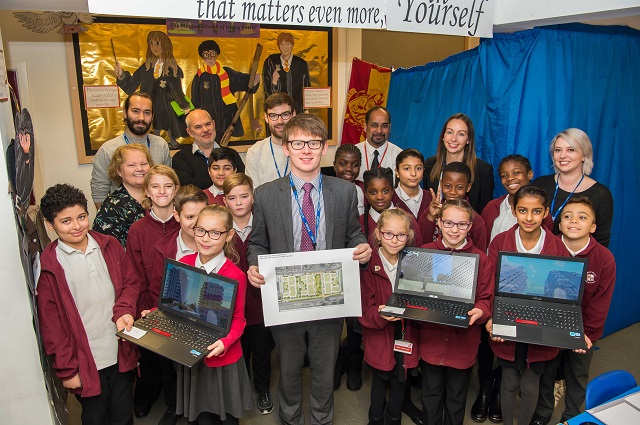
Primary school pupils road-test and improve estate design with the best ideas to be considered by Wates Residential and Havering Council for £1bn scheme.
Ten and 11-year-olds in Havering have been using their gaming skills to road-test and improve the design of one of the capital’s biggest regeneration projects.
Fifteen pupils from Rainham Village Primary School spent a morning using the computer game Minecraft to explore and redesign the Napier House and New Plymouth House sites, which are being redeveloped as part of the borough’s plans to create thousands more homes for local people.
Led by BlockBuilders, which imports map details into Minecraft so models of real-world places can be created, the children used avatars to walk and ‘fly’ around the site’s proposed designs, which have been developed by architects and masterplanners JTP.
They were then given the chance to think about what they treasure most about the site, what they would trash and if they had any big ideas for improving the area.
The final part of the session gave the Year 5 and 6 pupils the opportunity to demolish and rebuild parts of the site through the Minecraft model.
The three-hour workshop, which took place today, saw pupils come up with ideas including a garden bridge, trampoline park, rooftop swimming pool, shopping mall and a water park, complete with showers and a ticket office.
During the workshop, one of the pupils, Hetty Brown, said: “It’s a really fun way of designing buildings that you might use when they’re built and you can see what it might be like to design things for a career when you’re older.”
The best ideas will now be considered for inclusion in the final scheme by joint venture partners Wates Residential and Havering Council. A video fly-through showing their ideas is also being produced.
The interactive workshop is part of the joint venture’s wider pledge to unlock meaningful opportunities for local residents and school children through the scheme.
The long-term partnership will not only help deliver a borough-wide legacy, but will also help tackle the construction skills shortage through increased investment in education, training and skills.
The Chartered Institute of Building (CIOB) has previously reported that the industry will need to find 157,000 new recruits by 2021 in order to keep up with demand.
The joint venture will see an overhaul of Havering’s existing Council accommodation, with the council’s current stock of 856 homes replaced with around 3,000 homes of mixed tenure over the next 12 to 15 years.
Delivering improved provision, the regeneration will increase council rented accommodation by 70 percent and will include 400 low-cost home ownership properties. It will also double the amount of affordable housing on the 12 estates.
The design team for Phase One includes BDP for landscaping, and architects JTP and Conran and Partners.
Kate Ives, Development Director for Wates Residential, said:
“Computer games like Minecraft provide a great opportunity for young people to experience some of the most exciting elements of construction and planning.
“Using innovative and engaging ways to encourage interest in career opportunities in the sector is vital for the success of the industry and a great way of inspiring young people to think about their own futures.
“We are really excited to review the best ideas with Havering Council and look at how we can use them on the scheme, which will deliver thousands of new homes for local people as well as a borough-wide lasting legacy.”
Councillor Damian White, Leader of Havering Council, said:
“This is a great opportunity to engage our young people with the Council’s ambitious regeneration plans which are set to benefit the next generation with affordable homes, unique skills and training, and greater local career prospects.
“This is one of many social programmes ensuring our partnership with Wates Residential delivers much more than just housing. The project will create life chances for our young people and significant opportunities for local businesses.
“I look forward to seeing what innovative ideas our young people come up with and how it might shape future developments in the project – and might even give the architects a run for their money!”
Rebecca Taylor, Partner at JTP, added:
“The use of Minecraft in our collaborative planning process has been an eye-opening learning experience.
“JTP understands the need to adapt and evolve our practices alongside our audiences. In effectively utilising Minecraft as a collaborative planning tool we can engage more young people in the process of designing responsive, inclusive and socially sustainable new neighbourhoods with a unique identity.”

